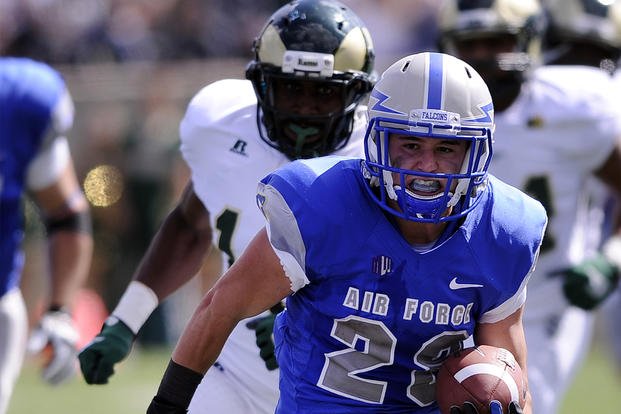Continuing the ongoing series of articles on the different athletic histories and body types that join the military, this post focuses on the powerlifting football player.
There are many strengths and weaknesses this type of athlete brings to the table when joining any military branch. The next several weeks, the topics of preparing for the military will focus on the different types of recruits and the different training and preparation journey each may need to be ready for whatever branch of service they choose.
The Power-Lifting/Football Athlete’s Strengths
The football-playing/power-type athlete comes to the military with many strengths and some weaknesses that need to be remedied prior to arriving at military basic training. That is especially true of military special-ops programs, where weaknesses are exposed quickly. Here are many of the strengths, both physiological and intangible.
Team player. Many football players know how to work well together as a team. The team has to "follow orders" and move the ball down the field together, relying on each other the entire time. Receiving negative feedback from a coaching staff is part of the game, and corrections on the spot occur all season for the football player. These skills go very well in a military environment.
Strength. Football players and power athletes typically are strong, period. They also may be fast and agile on land and typically do well on shorter, faster runs; log PT; load-bearing exercises (rucking); and typical upper-body fitness tests.
However great their strength and short-distance speed is, their endurance and muscle stamina need to be improved. This may require a significant amount of time away from power-lifting routines and short sprints, as well as more time doing calisthenics and running (rucking and swimming, depending upon the service). See similar story.
Mental toughness. You do not get to be a good football player without being mentally tough and enduring pain or playing through injuries. Two-a-day practices, tackling drills, getting dirty and picking yourself up off the ground every play is tough to do. This also translates well to wearing combat gear, such as body armor, a helmet, backpack and carrying weapons.
Every game is a personal gut check that has a week of preparation and planning as a team. These athletes are tough and know how to suck up pain and endure discomfort well.
Body composition/weight. As you will see, this is a strength and a weakness. The bigger athletes tend to have a lot of muscle mass; some are lean, some are not and struggle with the height/weight restrictions.
With this mass comes general durability. However, the impact forces and cardiovascular conditioning of running can be tough, especially since this athlete tends to think anything more than 100 yards is long distance. Meeting the standard for the 1.5- to three-mile timed runs of the various services generally is a challenge.
Many of these athletes have to lose weight in order to be a faster runner, or do more higher-repetition calisthenics like pull-ups and push-ups. That may mean losing some of the strength and power in favor of more muscle stamina and cardio endurance.
The Weaknesses of the Power Athlete/Football Player
Preparation for longer endurance/stamina. Football players typically come into the military preparation training knowing fully what their weaknesses are; they tend not to do so well on the timed runs. At group PT, multiple sets of high-repetition calisthenics tend to fatigue them quickly as well.
Accepting this weakness before entering -- even up to 6-12 months prior -- is a logical approach to high-level preparation for military basic and beyond. This will require losing some of the weightlifting one-rep max scores of previous years, but you can trade them for faster runs and high scores on PT tests.
PFT Bible: Focus on the basics first.
Pure running/swimming ability. There will be very few running events this athlete will do well on if they do not prepare with a progressive running program for a good six to 12 months (typically). In typical 1.5- to three-mile timed runs of the various military services, the heavier power athlete likely will struggle, compared to most people -- even on a good day.
Many athletes who play power sports are not into swimming. Learning how to swim if considering some military professions is critical and could add significant time to your adequate preparation -- maybe even another year (if SEAL, EOD, diver, PJ, RECON).
To make this transition to a better running/athlete, the power athlete needs to:
- Eat less food.
- Not try to gain weight.
- Lift fewer weights for both upper- and lower-body strength; and
- Train hard in calisthenics in order to crush upper-body PT tests for a few cycles before serving.
For more running, swimming, calisthenics workouts, see program link.
Regardless of your athletic background, becoming a tactical athlete requires molding your current strengths to the service requirements and focusing on current weaknesses that could be detrimental to a new recruit or spec ops-student. If you are a current power-lifting, football-playing athlete, make sure you run longer and do more calisthenics in the offseason and work on your endurance/muscle stamina.
Previous athletes discussed:
Stew Smith is a former Navy SEAL and fitness author certified as a Strength and Conditioning Specialist (CSCS) with the National Strength and Conditioning Association. Visit his Fitness eBook store if you're looking to start a workout program to create a healthy lifestyle. Send your fitness questions to stew@stewsmith.com.
Want to Learn More About Military Life?
Whether you're thinking of joining the military, looking for fitness and basic training tips, or keeping up with military life and benefits, Military.com has you covered. Subscribe to Military.com to have military news, updates and resources delivered directly to your inbox.


















